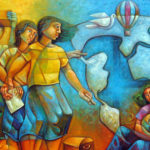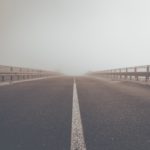CCDA Global Connections presents: Who is My Neighbor, a six-part blog series recounting stories and impacts from a trip to Central America, written from a CCDA perspective.
Part III: El Salvador, Scratching the Surface of a Nation
By Kit Danley and Kristen Chesmore
To begin to understand the suffering of El Salvador as a nation, we must revisit their civil war (1980-1992) and it’s martyrs, particularly the life and death of Monsignor Oscar Romero. This history adds to our understanding of why Salvadorians migrate in such massive numbers.
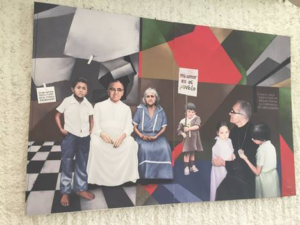 To deepen our understanding of the pilgrimage we would make to the site of Romero’s death, we sat with Mario Vega. He is the senior pastor from Mision Christiana Elim, the largest megachurch in the Americas, with 120,000 congregants.
To deepen our understanding of the pilgrimage we would make to the site of Romero’s death, we sat with Mario Vega. He is the senior pastor from Mision Christiana Elim, the largest megachurch in the Americas, with 120,000 congregants.
We learned much from Mario. He seemed both pragmatic and sad. After decades of migration, the family structure in El Salvador has eroded. Kids are raised by other kids, which contributes to the cycle of neglect and violence.
Gangs replace the family and the community is run by violence and abuse. Now, people flee from violence, further breaking the family structure. This leads to more gang affiliation, more violence, and the cycle continues.
With detail, Vega broke down how the Salvadorian church must move outside its metaphoric walls and engage with real people, real kids, before they become gang members. He insisted the church speak out against systemic evils and in his own words, “wake-up.”
To the American church he sent this message: “come here and learn the reality, don’t rely on the messages you have heard.”
The highlight of our pilgrimage to El Salvador was the chance to visit the holy ground of the compound where Monsignor Oscar Romero lived and was martyred.
The chapel is just as it was in 1980 when that deadly sniper’s bullet entered the heart of Romero in the middle of mass as he was lifting up the communion chalice.
Sitting in this pristine chapel we listen to Sister Maria Isabel, one of Archbishop Romero’s right hands, secretary, emissary, friend, and co-activist.
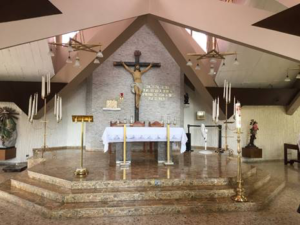
“We are witnesses of the light that is here,” she said, “the work of the Christian base communities formed after Medellin. It was and has been our responsibility to continue to carry the light in the world where darkness reigns. Monsignor taught that the church needs to be with the people, with the suffering. In his weekly homilies, which were heard all over Latin America, he denounced oppression by name. With his blood and his witness, he has marked the world.”
One of our teammates, Jose, was a teenager and member of one of the base communities where Maria Isabel worked in those days. Maria Isabel and Jose spoke of another nun, Sr. Silvia Maribel Arriola, Maria Isabel’s best friend and Jose’s youth leader.
Silvia was martyred also – her story is woven in with other martyrs’ during El Salvador’s civil war. Maria Isabel wants us to know Silvia as she did. She was a pioneer, one of the founders of the base community movement.
Maria Isabel tells us that Jose, who is now working in Honduras in a violent and extremely poor community, is the fruit of Silvia’s life. Maria Isabel reflects on her gratefulness to have experienced the solidarity in community that shared all things, from housing to food – it was as if they were experiencing the life of the early church.
El Salvador is a country marked by martyrs and the constant fear of persecution. Silvia is one of 672 leaders and catechists martyred from this parish alone.
Our visit ended with these words from Maria Isabel, “Each one of us needs to be contributing to all that creates life and is for justice, and through our actions transform a society which is divided into the powerful and the marginalized.”
She formed a prayer circle and sang a song of hope and faith and solidarity from the days of struggle. I could hear Jose singing the words with her.
It was hard to move on from holy ground, but we were to meet an impressive rebuilder of broken Salvadorian communities.
Rodrigo Bolanos is a business leader and founder of a massive garment factory called League. In 2009, Rod began to use his business acumen to launch an experiment in a neighborhood tortured by gangs, significant high school dropout rates and little hope of employment.
The idea is simple: hire the marginalized, focus on the excluded, partner with the local school, increase graduation rates, get kids into college to become professionals and find good paying jobs for college graduates.
Bolanos does all of this under the umbrella of a massive textile factory which makes college branded shirts.
Under one roof we experienced people working, attending college courses, and taking English classes. Rod wanted people from extreme poverty to have a fighting chance. We left with gifts of hope!
Our day ended at the Jesuit University with researchers focused on the issue of immigration. Their acumen is significant and we glimpsed the highly complex social environment that surrounds the issue of migration, how it has impacted the country and how El Salvador has changed because of it.
They study the massive increase of violence related to gangs, and how migration and violence go hand in hand. Family reunification and fleeing violence push Salvadorans to migrate.
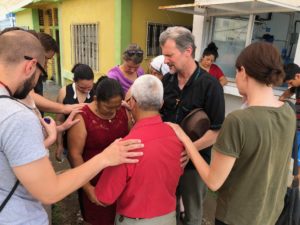 Gang members have become professionals, going into politics and influencing the country. Human rights violations abound. Attempts at reducing gangs and their activities have failed, under more than one initiative.
Gang members have become professionals, going into politics and influencing the country. Human rights violations abound. Attempts at reducing gangs and their activities have failed, under more than one initiative.
So punitive approaches are frequent. Gang members are housed in inhumane conditions, having little to no contact with the outside world. In their communities, there are cases of extermination by paramilitary groups made up of family members of the gang affiliated.
One political leader summarized, there are 60,000 gang members, and their families – 400,000. All these are not citizens. In other words: these are not humans, eliminate them.
People are going to migrate, with or without walls. Their logic is simple: they will die here, and they may not on the way north.
The message to the Salvadorian church is to denounce what is happening!
Denounce what they know is going on with violence and with politics, especially how it is affecting the poor. Teach churches how to embrace new concepts, how to move into civil disobedience and to commit to the function of reweaving the social fabric of the country.
Our hearts are broken. We are changed. We will act.
Missed Who is My Neighbor Part II: Honduras? Continue the journey as we deepen our understanding of migration, welcoming the stranger, and caring for our neighbors in Central America.
_________________
Kit is the founder and president of Neighborhood Ministries, Inc. – a comprehensive, holistic outreach that combines social justice work with many forms of community development. This 36 year old work has been featured in magazines like “World”, “Christian Century”, and “Christianity Today”. This mission focuses on the hardest problems in Arizona and Phoenix — one is to see many young people out of the community take on the leadership roles our community desperately deserves and needs. Traveling to Central America changed my life.
Kristen Chesmore lives in Bellevue, Washington (a suburb of Seattle). She studied Literature and Religion at Whitworth University. Currently she volunteers with World Relief visiting people in the immigration detention center in Tacoma. This past year she has led a “Good Neighbor Team” which is a program of World Relief that partners with the local church to come alongside refugees or Asylees. Her team is currently assisting three men from Africa, all who won asylum, get their start here in the US.

